Industry update: Rough terrain scissors
05 July 2022
Rough-terrain scissor lifts are quite possibly one of the most easily identifiable pieces of equipment on a jobsite. From electricians to fabricators, RTs are widely used both indoors and out on sites around North America. ALH spoke to North America’s largest scissor lift manufactures to get a feel for demand, delivery problems and what’s to come. Here’s what they had to say.
ALH: How is the market for RTs fairing now compared to the same period last year? How do you see the next 12 months shaping up for RT scissors?
JLG’s Bob Begley, director of product management – scissor lifts, vertical lifts and low-level access lifts: As the Covid-19 crisis in North America continues to decline, construction activity is accelerating. Pent-up sales from equipment purchases delayed during the pandemic, replacement cycles and fleet growth are all contributing to strong demand for JLG products across all categories, including rough terrain scissor lifts.
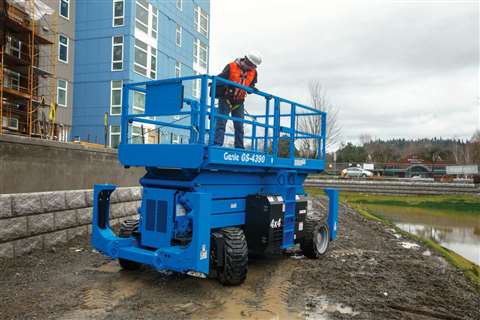 Genie says it is possible there will be a move toward taller scissors as demand increases. (Photo: Genie)
Genie says it is possible there will be a move toward taller scissors as demand increases. (Photo: Genie)
Genie’s Christian Dube, associate product manager: Last year, demand for all types of equipment increased following the decline we saw in 2020 as a result of the COVID-19 pandemic. Since then, demand for equipment, including RT scissor lifts, has remained strong.
Skyjack’s Corey Connolly, senior product manager: In 2021, the North American RT market showed significant gains over 2020 and this trend was increased during Q1 of 2022. In Europe, while recovery is evident, it lags that of North America in volume although rate of growth is similar. In Asia-Pacific, the RT has proven less popular in Asian markets, while Australia is showing similar recovery rates as Europe and North America.
ALH: How do you see the next 12 months shaping up for RT scissors?
Connolly: For the remainder of 2022 and going into 2023 the market demand is seen as continuing to grow as rental companies look to re-fleet post Covid.
Dube: As a result of strong demand and global supply chain disruptions, pretty much all manufacturers are experiencing backlogs. This includes RT scissor lifts. As a result, demand is expected to remain robust for at least the next 12 months, if not longer. Of course, that demand does have some dependency on market conditions. So, if there are any significant changes with the economy as a whole, it’s possible that demand could change. But, barring any significant events impacting the construction economy, demand should remain high.
ALH: What regions or markets are seeing higher utilization for RT scissors? Why?
Dube: The highest utilization for RT scissor lifts is in Europe.
 JLG says telematics and electrification are top trends. (Photo: JLG)
JLG says telematics and electrification are top trends. (Photo: JLG)
Begley: Scissor lifts, in general, are common jobsite tools, and we continue to see strong demand globally for both rough terrain (RT) and electric rough terrain (ERT) units. In North America, we are seeing an increase in warehouse construction. JLG RT and ERT scissor lifts have proven popular on these jobsites.
JLG RT/ERT lifts offer full drive at height capabilities, allowing the operator to work at a fixed height along the length of a building when installing utilities inside or out. Earlier models did not offer this feature, meaning the operator would have to descend, then move the machine to the next work area, then ascend again to continue the work. The recently introduced JLG models that allow work at a fixed height offer exceptional productivity benefits.
Utilization varies based on seasonality and concentration of construction activity in and around an area. In general, the rough terrain scissor lift market is mature with steady demand year-round.
ALH: How have supply chain issues impacted the production of your RTs? What are the lead times for your RT scissors right now?
Begley: JLG continues to supply its customers with product, despite ongoing supply chain disruptions. We continue to optimize the manufacturing footprint at each of our facilities, even adding lines in new locations where practical to meet market demand.
Dube: For the past year, as you know, the issues affecting the global supply chain have had an impact on equipment manufacturers’ ability to meet customer demand for new machines. Genie hasn’t been immune to those challenges, and we’ve felt the impacts across our manufacturing facilities and product lines — including our RT scissor lifts. As a result, we have a strong backlog and are continuing to look for ways to best deliver the equipment our customers want from us in as timely a manner as possible.
ALH: What changes/updates to RTs should the market be on the lookout for in the coming years?
Dube: As mentioned, Europe is a big market for RT scissor lifts. It’s also a market that is highly focused on electrification. That, combined with the fact that we’re seeing a trend toward electrifying scissor lifts in general, leads to the natural conclusion that we’ll likely see RT scissor lifts move that way.
Of course, there are challenges to solve before full electrification will make sense for all rough terrain scissors, especially since these machines are often on the jobsite early in construction, before electricity is readily available. But, as the industry begins to solve this charging infrastructure challenge, you’ll see more and more equipment electrify — including RT scissor lifts.
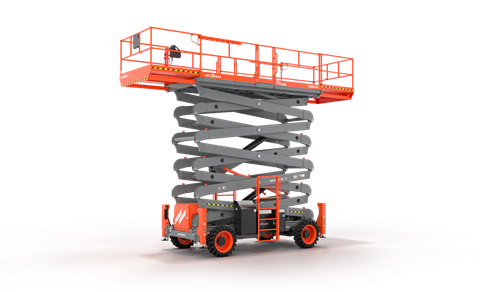 Skyjack recently overhauled its entire RT scissor product line. (Photo: Skyjack)
Skyjack recently overhauled its entire RT scissor product line. (Photo: Skyjack)
Begley: We believe there are three trends that will continue to impact machine design in the coming years, and JLG is well-positioned with our RT/ERT scissor lift line to respond to meet the market demand.
Higher lifting capabilities
With building footprints getting narrower and taller, customers are looking for equipment that offers greater lift height. Users also want to bring more materials and people to the work area, which drives the need for higher capacity.
JLG RT/ERT scissor lifts are well-suited for this type of work because of their large platform. They offer 28 percent more working area than competitive models with class-leading capacities. JLG’s models are designed with zero-platform offset to minimize the distance users must reach to access the work area. And, to navigate through tight spaces more efficiently, these JLG machines are equipped with easy-fold rails, which can be collapsed in three minutes or less.
Electrification
Due to an increase in demand for electric-powered lifts globally, when JLG announced its fully redesigned rough terrain scissor line in early 2020, it included both engine-powered RT and electric-powered ERT models in each size class.
We expect to see electric models continue to gain popularity as battery technology advances and environmental considerations become more and more stringent. For example, when JLG introduced the world’s first all-electric slab scissor lift model, the JLG AE1932 DaVinci lift in 2021, it was engineered as the first-of-a-kind lift with zero hydraulics, thereby eliminating the potential for leaks, and powered by a single lithium-ion battery that recharges as the lift descends to lengthen the operational time between charges. We believe some of these same market-leading technologies will grow in popularity and that over time customers will request they be included in other models.
New technologies
We also see demand in the rough terrain scissor lift market for new technologies to solve the most common job site challenges.
For example, the redesigned JLG RT/ERT lines are equipped with LiftSense, a standard and exclusive JLG feature, which shows operators the maximum work height that can be achieved before they elevate based on side-to-side and front-to-back tilt, as well as the current capacity in the platform. This means that operators can see if they should take a little bit less material with them or if they need to get to a spot that’s a little bit more level on the job site so that they can get the full height — it removes the guesswork that often results in operators having to descend and try again for marked productivity gains.
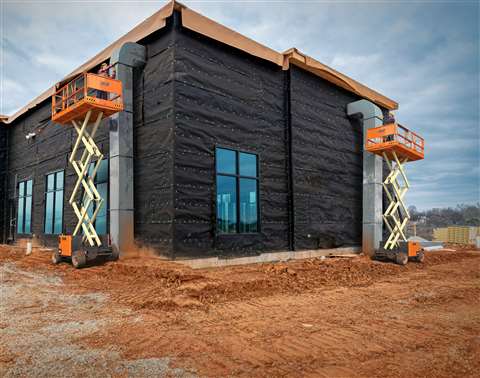 JLG is experiencing strong demand across all scissor lines. (Photo: JLG)
JLG is experiencing strong demand across all scissor lines. (Photo: JLG)
New technology on JLG RT models includes a QuikLevel Advanced feature, which automatically levels the machine on side slopes up to 4.5 degrees while allowing the operator to drive at full height under certain conditions. The machine’s sensors monitor platform load, platform height, front axle tilt, rear axle tilt, and chassis tilt, then automatically level the lift based on ground conditions.
ALH: Outside of A92 design-related changes, what’s one of the biggest updates RT scissors have seen recently? Why?
Dube: Outside of the A92 changes, really the biggest change has been the move toward using data to manage and maintain a fleet, including rough terrain scissors. Genie RT scissor lifts are tried-and-true workhorses on the jobsite. But, by leveraging the data provided by Genie Lift Connect telematics, equipment owners are now able to get even more out of the RT scissors in their fleet. A few examples include the below.
Fault codes and sensor values can provide valuable insights for fleet and service managers and help to remotely diagnose a machine that is having trouble in the field. Identifying the problem before a technician is on site means the equipment can get fixed faster, because the technician can ensure he or she has the necessary tools and parts before arriving on site.
Telematics data can also help an equipment owner better plan for preventative maintenance, which is important for uptime. Using telematics data can help track overall fleet health, and ensure that routine maintenance and service is performed when in a timely and convenient manner, helping ensure equipment is ready to rent and in optimal condition when an opportunity arises.
A third example: Lift Connect customers have an opportunity to add Access Manager on to their Lift Connect subscription. With Access Manager, equipment owners can remotely manage access to their fleet and ensure only authorized users can operate a machine.
Begley: One of the biggest updates RT scissors have seen recently is electrification. Traditionally, rough terrain models were powered by combustion engines, but with demand growing for environmentally friendly equipment in this type of machine, we’d expect to see more and more electric-powered options.
ALH: Excluding electrification, what other trends are occurring in this sector? What’s next for RTs?
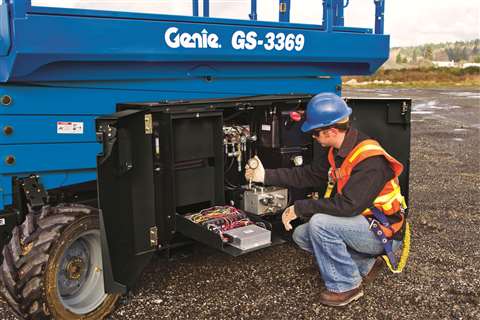 Genie says RT scissors will likely see electrified power options soon. (Photo: Genie)
Genie says RT scissors will likely see electrified power options soon. (Photo: Genie)
Dube: That’s a hard question, because electrification really is the biggest trend for nearly all types of equipment. But, in this case, beyond electrification, it’s possible you’ll see a move toward taller RT scissors as demand increases for higher-reaching equipment.
Aside from that, Genie rough terrain scissors are a proven workhorse in the market. So, we see continued use and strong demand for them.
Begley: Like slab models, we are striving for rough-terrain scissor lifts to become efficient for use in/around sensitive environments (data centers, hospitals, laboratories, industrial chemical facilities) and in extreme environments (below-freezing or high heat temperatures.
ALH: When considering an RT purchase, what are three main points/tips you can provide for rental companies?
Dube: Quality matters with any type of construction equipment, but it’s definitely something to think about with rough terrain scissors, which need to perform reliably and have to be extremely durable in any type of terrain. For this reason, total cost of ownership and rROIC should be an important consideration, beyond just the initial purchase price. If a machine is broken down a lot, or needs a lot of repairs, it not only costs more to maintain, but it isn’t on rent making money. Genie RT scissors have been a leader in the market for a long time because they are so reliable and durable and come with the superior service and aftermarket support that Genie is known for.
Begley: When looking to buy rough terrain scissor lifts for rental applications, rental companies must consider these three things:
Understand the job and work to be done by customers.
Some users are working 8+ hour days, and runtime is a big deal. Understanding how long these machines need to run each day to complete the work is essential to choosing the right model. For example, will the scissor lift need to run on continuous shifts, or will the renters have the opportunity to charge the machine between shifts?
Know the lift height and capacity needed for the customers’ job.
The demand for greater lift heights and capacity is growing. Rental companies should look for models that offer improved productivity and increased range of operation to meet customer needs.
Understand what options and accessories are available and equip your fleet to best meet the needs of customers.
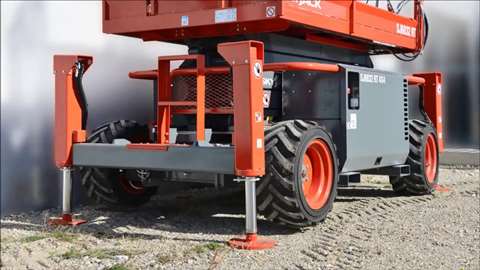 Skyjack is seeing a shift in demand toward higher scissor platform heights. (Photo: Skyjack)
Skyjack is seeing a shift in demand toward higher scissor platform heights. (Photo: Skyjack)
Many manufacturers like JLG are now offering a wide range of accessories and options for scissor lifts, including new technologies. Knowing the type of work your customers need to complete and having the accessories and options available on the units in a rental fleet will help boost their productivity. Consider popular features like tool trays, power to the platform, panel cradles and pipe racks.
ALH: Anything else?
Begley: For rental companies investing in electric rough terrain scissor lifts, it is important to think about how these machines will be charged once on a job site. One of the biggest roadblocks to the mass adoption of electrified products remains a lack of electrification infrastructure to support charging. For equipment, this proves even more of a challenge during early-stage construction when power is not yet available. In these instances, companies will require some type of portable power to charge the electric lifts.
A beneficial tip we can offer to increase the utilization of electric-powered models is for rental companies to embrace advances in battery monitoring. Tracking battery use and recharge cycles will not only ensure maximum machine uptime but also reduce the machine’s total cost of ownership due to prolonged battery life. JLG offers an advanced battery monitoring system (ABMS), a digital tool designed to help equipment owners and operators monitor the charge status of their scissor lift/s for this reason.
STAY CONNECTED



Receive the information you need when you need it through our world-leading magazines, newsletters and daily briefings.
CONNECT WITH THE TEAM








